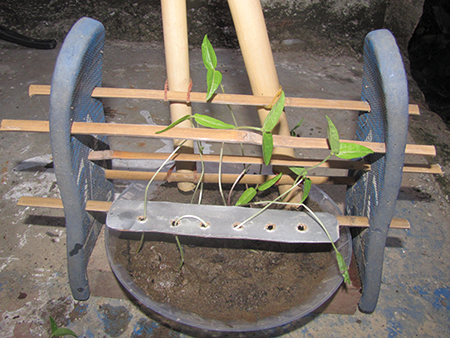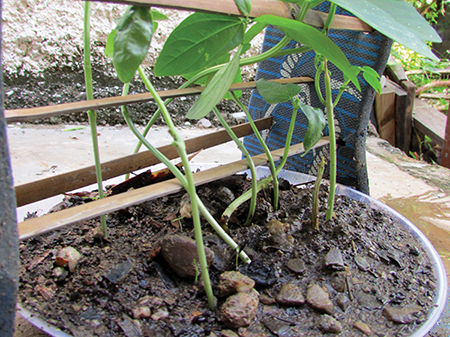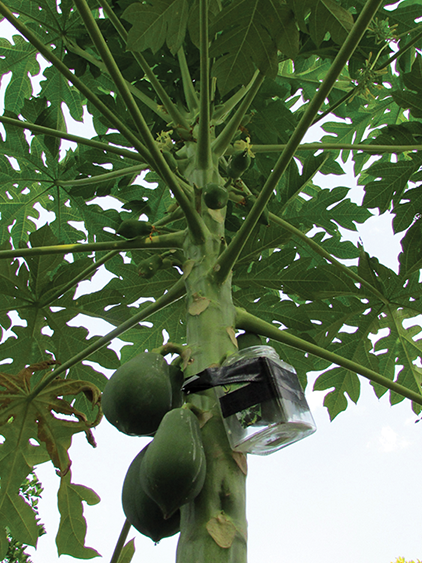Chapter 11
Tinkering with Plants

Get plants to grow in funny ways.
Near Watsonville, California, there is an amusement park with some trees that were tinkered by a very patient man into astonishing shapes: circles, squares, grids, telephone booths, spirals, arches, and more. Ask your Uncle Google about Gilroy Gardens Circus Trees. While I was inspired when I saw these, I knew I didn’t have the patience to see one of my own through to such a marvelous result. Thus it was that I began tinkering with faster-growing stuff. This chapter displays some of our recent efforts here in the tropics.
Gather stuff
- Seeds, cuttings, shoots, whatever you think may grow
- Pots, cups, plates, boxes, whatever you think the plants may grow in
- Scrap wood, metal, plastic, whatever you need to coax the plants to grow the way you want
- Dirt
- Water
Tinker
My teacher buddies here use mung bean sprouts to do germination and growth experiments because they really shoot up in the first few days of their lives. So we also try to get some to weave themselves in interesting ways around a lattice. We plant them in a plate of dirt under the lattice. Here is the most recent run:


See them going in and out of the holes? That all takes place within a week and a half and is pretty cool, but then they often stop growing. You can also do this with PVC bits. We wait until the sprouts emerge and then fasten each tube down over a sprout so it has little option but to venture up the tube. In the photo here, all but one came out, and it had the hardest road: a 90-degree angle after a long straightaway. Its first leaf is 1 cm inside the opening.

I find these mung bean sprouts speedy but fragile. Looking for something more robust, I recently reached for the string bean seeds. Here’s what I got:


You can see them looping around the horizontal beams quite nicely. It’s been about three weeks now and that’s where they are as of this writing. I expect to be looping them around for a few more weeks until they get tired and start producing beans.
I noticed a vine growing up the side of our house. I got a tube and stuffed it partway down. It knew what to do.

This opens up all sorts of possibilities. I bet I can make a veritable spider web with this maverick vine, given time.

I found photos of square pumpkins and watermelons on the Internet. The creative farmer had built a wooden box around a baby pumpkin and that shaped its future. We can do the same thing with a papaya, only with a glass jar. You have to break the jar to get it out. This one is filling out quite nicely in its square prison.
You can also alter the future of shoots and trees. This is our new banana sprout and another baby tree in our front yard. I just gave them rings: a piece of PVC and a bottle cap with the top cut out. Fashion accessories, you could call them.


It’s fascinating to watch the plant deal with these bangles. Both of the rings in these photos have been in place for more than a month, and the trees seem to be accepting them well. The tree with the PVC will not press on it for years probably, but the banana tree has already begun stretching the ring and squeezing itself.
(That big ugly stalk next to the banana spout with the bottle cap ring is its mummy. It’s around 6 meters tall, two years old, and we’re still waiting for the bananas to come. Bananas usually don’t reproduce with seeds, but rather send out shoots like this that result in more plants right around themselves. Redwoods can do something like this too!)
Another thing we’ve done that’s easy and instructive is to tie knots in plants. Anything that’s limber enough can be twisted on itself to become a simple knot, and then monitored to see if it keeps growing and in what manner. This chapter’s introductory photo is a coconut frond all dolled up with decorative knots, which it seems to be reasonably happy with. Two more we’re currently monitoring are here:


I’m sure you can think of other creative ways to get plants to do crazy things. By the way, this is clearly a lazy person’s tinkering technique: 5 minutes of action, many months of pleasant observations.
What’s Going On?
The issue of plants growing is fascinating in and of itself. We animals have muscles that pull on bones and move us around. Plants don’t have muscles. Plants have cells with stiff cell walls—that’s it. Any growth or movement that they do is by multiplying or changing of shape of these cells. A number of plants in Timor make movements. One, called “Shy Maria,” closes its little array of parallel leaves if anything touches it. Another, which looks a lot like the one I ringed earlier, is called the “Sleepy-eyed tree,” and closes up its leaves tightly every night.
How do they do this? It’s the same question as for carnivorous plants: How does a Venus fly trap close so quickly and catch insects without muscles? The details are complex and I’m no expert, but the answer is the same: by multiplying or shape-shifting cells.
I’m impressed with the speed of many plants here. That papaya tree in an earlier photo is 5 meters tall and scarcely over one year old. Look at those fat papayas hanging up there. Papaya trees grow fast because the trunk is full of air. The wood is more like a honeycomb than a solid piece of pine or oak. When it dies, it decomposes into compost within a few weeks.
But other plants grow for a long, slow time. Teak wood and sandalwood trees take decades to mature. The speed of each plant is related to its priorities for life, which are dictated by its environment and have evolved and adapted over millions of years. Basically, all life around you is a brilliant success story. The failures are only visible as fossils. So enjoy your plants as you tinker, and remember: you need them!
